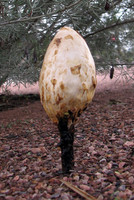
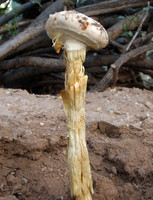
Podaxis and Montagnea mushrooms grow in the Sonoran Desert even at low elevations. They are quite common in parks, yards, and other open spaces in Tucson. Images ©
Mushrooms in the Desert?
 View Mushroom Hunting on Mt. Lemmon
View Mushroom Hunting on Mt. Lemmon
Every mushroom lover knows that in order to get mushrooms, you need two things: lots of trees and plenty of rain. So moving to a desert doesn't seem like a particularly smart thing to do, if you really care about mushrooms. Indeed, when I moved to Tucson for graduate school in the early 1990s, I was ready to sacrifice one of my favorite hobbies for a promising career as a dung fly biologist. But few things in life ever go as planned; so 15 years later, I have long left the dung flies behind, while still getting my pocket knife ready every summer for another season of mushroom hunting in the Sonoran Desert.
Actually, I'm rarely hunting mushrooms among the saguaros in the low desert zone. There are a few fungi that grow after rains in desert washes and even in my back yard in the city. But generally, the low elevations are not that great for wild mushrooms, especially if you are after ones that you can turn into a meal. In pursuit of mushroom diversity, abundance, and deliciousness, I usually head up to one of the southwestern sky islands. These mountain ranges are called "sky islands" because they rise from the desert floor like islands from the ocean. Some of these peaks are more than 9,000 feet high, and the desert below is as inhospitable to many of the sky island organisms as saltwater is to the land creatures that inhabit ocean islands. The communities of plants, animals, and fungi living on individual sky islands are therefore fairly isolated and unique.

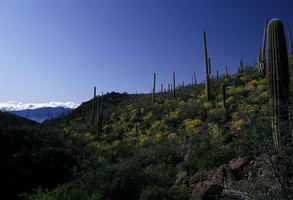
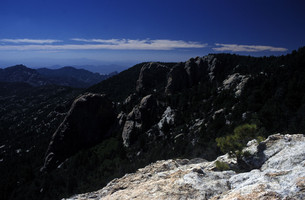
Saguaros grow at low elevations in the Sonoran Desert (left), but on the peaks of the sky island, like Mount Lemmon in the Santa Catalina Mountains (right), you'll find forests with real trees and, in the fall after the monsoon, a rich crop of mushrooms. Images ©
As you move up the sky islands from the desert, temperatures get much cooler, and the saguaros give way to real trees. The highest peaks have lush forests of fir, pine, maple, and aspen. In such an environment, all you need to get mushrooms is a little rain. As soon as the summer rains start, usually in June or July, it's worth going up the mountain to check out what's popping up in the landscape. If the monsoon is good, and we get a little more rain later in the fall, there will be new mushrooms coming out throughout the fall well into November. Some years you'll only find a few here and there, but at other times the hills go crazy with mushrooms in all colors of the rainbow. There are also a few spring mushrooms in southeastern Arizona, but they are not as plentiful as the summer and fall fungi.

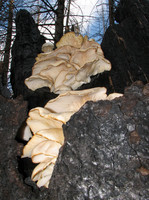
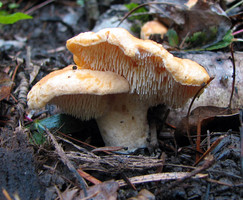
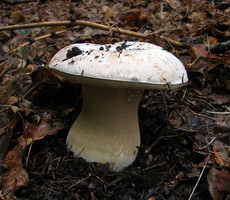
Some edible mushrooms that are common at high elevations in the mountains of southeast Arizona: The oyster mushroom, Pleurotus ostreatus, the hedgehog mushroom, Hydnum repandum, and the white king bolete Boletus barrowsii. Images © 2006
One of the coolest things about being a mushroom hunter in the sky islands of the Sonoran Desert is that there's hardly any competition! In many areas of the world, and even in parts of the United States, you have to get out real early in the morning during mushroom season, or all you'll find is scraps from other people's forays. But here in southeastern Arizona, mushroom hunters are almost as elusive as their prey. I rarely see signs of other mushroomers in the forest, and over the years, I've only run into a handful of them personally. If I meet fellow sky island mushroom pickers on the trail, I don't usually feel very competitive. This may be because each time this has happened so far, our party was the one with the larger bounty.
Becoming a Mushroom Hunter
If you are interested in becoming a mushroom hunter, the first thing you need to know is that eating mushrooms can be dangerous. In this respect, mushrooms are not different from any other wild food. Just like there are poisonous mushrooms, there are poisonous plants and poisonous animals. For example, you wouldn't want to snack on coralbeans, Erythrina flabelliformis, or taste a Colorado River toad, Bufo alvarius.

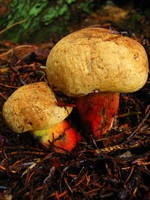
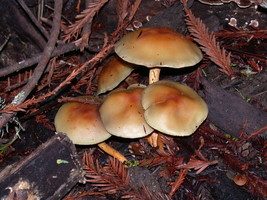
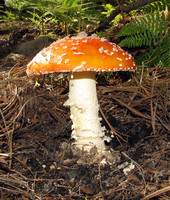
Some poisonous mushrooms that are common at high elevations in the mountains of southeast Arizona: Satan's bolete, Boletus satanas (image © 2006 Sergio Nasi), sulfur tuft, Hypholoma fasciculare (image © 2006 Darvin DeShazer), and fly agaric, Amanita muscaria (image © 2006 ).

If you want to collect and eat any wild food, you need to learn how to tell the edible species from the poisonous ones. The best way to do this is to apprentice with somebody who knows the mushrooms in your area. If you don't have any friends or family who can teach you, you can look for guided tours offered by your local mushroom club, mycological society, or nature center. You can also teach yourself using a few good field guides and online information. However, before you ever make the decision to eat a mushrooms you have found in the wild, you really need to do your home work. The color and shape of many mushroom species is highly variable, and many poisonous mushrooms look quite similar to edible ones. Therefore, you cannot confidently identify an edible species until you know all its poisonous look-alikes in your area.
If you are an aspiring amateur mycologist in North America, the best introduction to the art and science of mushroom hunting is David Arora's All that the Rain Promises, and More... (Arora 1991). This little, inexpensive book is a good field guide to common species, with a bit of a bias towards Western North America, and it also has a lot of great pictures and funny little stories to get you into the spirit of mushroom hunting. Another outstanding book for the beginner is Edible Wild Mushrooms of North America by David Fischer and Alan Bessette (Fischer and Bessette 1992). This book does not cover a lot of species, but it gives very good instructions on how to identify some of the most common edible and poisonous species. It also has great recipes that will help you to properly enjoy your prey. Once you have learned the basics of mushroom hunting, you really need to get yourself a copy of David Arora's Mushrooms Demystified (Arora 1986). This classic tome mixes identification keys and species descriptions with a good dose of humor and inspiration. It's a real page turner and required reading for every serious mushroom hunter in North America.
Information on the Internet
- Arizona Mycota Project The Arizona Mycota Project (AMP) solicits the help of volunteer contributors to help advance our knowledge of the Arizona fungal flora (mycota).
- Robert L. Gilbertson Mycological Herbarium at the University of Arizona The Gilbertson Mycological Herbarium at the University of Arizona houses over 40,000 accessioned specimens of fungi and fungus-like organisms, with special collections of rusts, polypores, and corticioid fungi.
- Arizona Mushroom Club The Arizona Mushroom Club is an organization of people with an interest in collecting wild mushrooms for food and for those wanting to learn to recognize edible mushrooms from poisonous ones.
- MykoWeb A web site devoted to the science of mycology (the study of the fungi) and the hobby of mushrooming (the pursuit of mushrooms). It's mostly focused on California mushrooms, but there is a lot of general information, and many Arizona mushrooms also occur in California.
- Mushroom Observer The purpose of this site is to record observations about mushrooms, help people identify mushrooms they aren't familiar with, and expand the community around the scientific exploration of mushrooms (mycology).

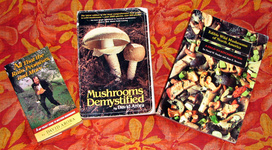
 This page was developed as part of the project "New Strategies for Life Sciences Outreach in Arizona: Developing a Digital Library of Audio and Video Features in the Context of the Tree of Life Web Project" funded by the
This page was developed as part of the project "New Strategies for Life Sciences Outreach in Arizona: Developing a Digital Library of Audio and Video Features in the Context of the Tree of Life Web Project" funded by the 



 Go to quick links
Go to quick search
Go to navigation for this section of the ToL site
Go to detailed links for the ToL site
Go to quick links
Go to quick search
Go to navigation for this section of the ToL site
Go to detailed links for the ToL site